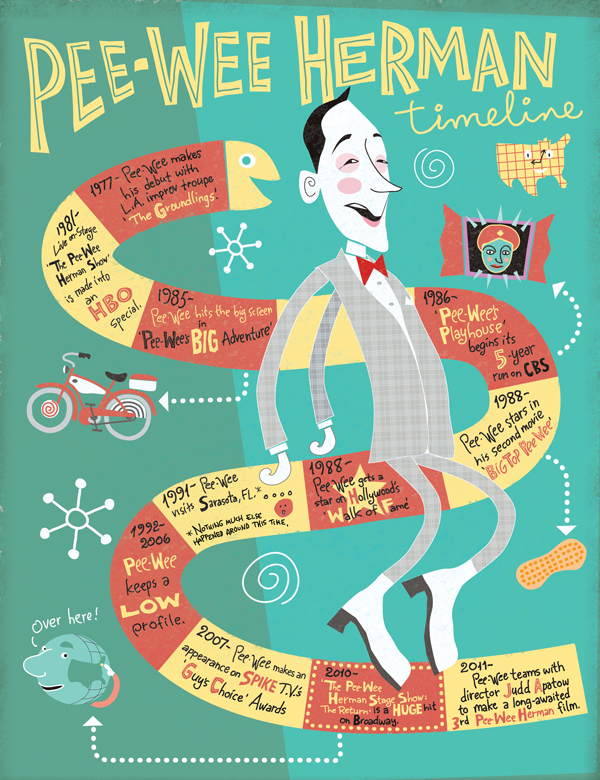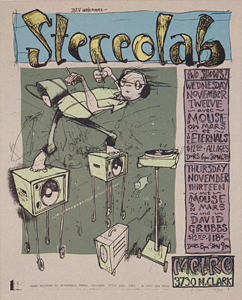Sometime during the early 80's, I first saw Pee-wee Herman on the David Letterman show, where he was a recurring guest. At the time, I really didn't know what to make of the character, an invention of improv comic Paul Reubens. But with every appearance, his brand of humor grew on me. The release of "Pee-wee's Big Adventure" made me a fan for life and "Pee-wee's Playhouse" was must viewing for my wife and I and later, for our kids.His recent "renaissance", with a wildly successful broadway show and plans for a new film, was welcome news to me and I'm sure to his many other fans. There were rumors of Johnny Depp taking over the role of Pee-wee in a movie sequel (only SLIGHTLY less ill-conceived than having James Brolin play the part) and there seems to be a grassroots internet movement to draft Jim Parsons ("the Big Bang Theory) as a replacement Pee-wee should that time arrive. As I see it, Reubens is, and will remain, the one and only Pee-wee Herman.
Faces on a Train: first installment
For years I commuted to downtown Chicago's Loop, riding the "L" train through the west side of the city. Now I ride only occasionally and at off peak hours, which gives me a chance to sketch some of the riders unobserved. With an endless supply of faces and poses to serve as inspiration, it's fun to experiment with a different styles. Here I've composited a few of these sketches digitally with some of the amazing photos my wife, Lynn, has taken during her commute.
And I couldn't resist posting a few more of Lynn's pictures on their own:
I hope to continue this series from time to time, so Green Line riders be forewarned!
My "Bird Machine" illustration
Last week I posted an interview with the amazing gig poster artist and owner of "The Bird Machine", Jay Ryan. (Thank you, Jay!)
I usually head up my blog posts with an original illustration, but in this case, I decided that using my own illustration to head up a blog post featuring another artist's work didn't fit quite right, so after already doing an illustration based on "The Bird Machine", I shelved my own piece and uploaded a photographic treatment of Jay instead. So now I thought I'd post the original illustration on its own.
The bird was created in Illustrator and enhanced in Photoshop. The background was from a photo I took last fall of a pile of leaves that I posterized/colorized. Comments welcome.
Interview with "The Bird Machine's" Jay Ryan
In the world of band show posters, known as "gig" posters, there are few artists with the stature (physically as well as artistically) of Chicago's Jay Ryan. From his storefront screen printing facility in Skokie, Illinois, called The Bird Machine, Jay cranks out thousands of posters for famous and not-so-famous bands including his own, Dianogah. Gig posters have become recognized as a cool and collectible art form that are prized long after many of the bands whose shows they promote are no longer around. Along with graphic novels, gig posters have seen a surge in popularity that goes far beyond their core audience.
I recently caught up with Jay at the Daily Planet Rock and Art Poster Party to celebrate the 20th anniversary of Steve Walters' Screwball Press and he was kind enough answer a few questions:
Q: In one of your previous interviews, you mention one of your painting teachers, Peter Kursel, by name, but it doesn't say where you went to school. How important do you think a formal art education was for you and do you think having an art degree is a great advantage for artists in general?
Jay: I went to the University of Illinois in Urbana, which was the only school to which I applied where I couldn't get into the architecture program. I started in industrial design, but soon switched to painting, largely due to a cute girl in the painting program (and 19 years later we're still together). Peter Kursel was mentioned in that interview, but Roger Kotoske, Barbara Kendrick, Sarah Krepp, Tim van Laar and Dennis Rowan were all important to my education. I think Tim van Laar is the only one of those I've mentioned who is still teaching in Urbana.
While there are tons of exceptions, including some of my favorite artists, I think that a formal education is generally a good foundation for making work, so there's a sense of context to what you're doing. Learn the rules so you understand where the lines are, and then you're able to decide when you want to work inside the lines or draw outside of them.
For me, the "formal" part of the education played a minor role in what I now perceive that I learned in school. The figure drawing, line weight, color sense, painting techniques and proper way to cut foamcore were all important, but as I mentioned in that previous interview, I got more from a couple "lessons" I learned about how to redefine what a drawing could be, to lower my expectations away from "drawing well", and to be able to work around the tendency to freeze up when trying to create an image.
Q: In your book "100 Posters:134 Squirrels" you mention that one of your pieces, the cover for Michael Chabon's "The Final Solution" was originally colored in Photoshop then recreated using traditional screen printing techniques. As a traditional screen printer, what are your feelings regarding digitally created art as a medium? Do you use the computer at all at any stage of your creative process?
Jay: Generally, I don't use the computer for my poster work. I usually* pride myself on making my prints entirely with hand-drawn linework and text, and hand-cutting the separations for printing. I do use Photoshop when I design album covers or t-shirts for bands, but I use the program in the same way that I make my screenprints, by scanning in a pencil drawing, and coloring the layers in the same way I would by hand. This is useful when the project is something that's not going to be screenprinted, or isn't going to be printed by me.
* I say "usually", as I am currently without access to a good Xerox machine for making my key plate films, so for the last 3 or 4 months I have been scanning my pencil drawings into Photoshop and having them output as a film by the service bureau next door to my shop. So I can't technically claim to be computer-free right now.
Q: On the subject of the creative process, how do you work out your ideas? Much of your finished work seems to have a fresh, sketchy look to it. Do you keep a sketchbook or written journal of ideas?
Jay: No, I take forever to fill sketchbooks. I don't normally just draw for drawing's sake. I guess I get that itch scratched by pretty much all of the projects I work on, as I feel like they're all my personal work. I just go "Oh, okay, next is a Melvins print." I listen to the Melvins, and hope that something comes to me quickly.
Q: Has the recession affected the gig poster market? Screen printed gig posters seem like a great way for music fans and art lovers to get original limited edition artwork at an affordable price and I've got to say, as nice as the pieces look in the book reproductions, nothing beats seeing the richness and grain of hand pulled screen prints.
Jay: As a small business owner with employees, I have the same economic concerns as everyone who isn't a banker-pirate, oil baron, or overpaid conservative talkshow pundit. However, due to the fact that our business model is accidentally based on the idea of getting lots and lots of little paychecks instead of a couple of big paychecks, we're continuing to do slightly better every year.
Q: As a new and first time dad, do you find your perspective has changed in terms of balancing home and work and when will you give your daughter her first lesson in screen printing?
Jay: This is sort of an ongoing struggle, which we don't see resolving for a couple of years. My wife and I both run our own businesses, and we're trying to find the right ways to balance spending as much time as possible with the baby (who turns 6 months next week) while maintaining our respective careers. What we each do is unlike a job at the store, where you can take off for a year, then get another job at the store and things are basically the same. If I were to drop out of working for a year (or more), I think I'd lose some of my audience, and many of my clients. As for lessons, we'll see if my daughter has any interest in what I do. At the moment, she's way more interested in getting her toes into her mouth.
________________ Many thanks to Jay Ryan for giving me a rare peek inside The Bird Machine. His posters have been published in two collections including the aforementioned "100 Posters:134 Squirrels" and "Animals and Objects In and Out of Water". His work and that of many other incredible gig poster artists can also be found at gigposters.com.
Jack Johnson and the "Fight of the Century"
Here's a printed version of the text above:
"When asked to reveal the secret to his legendary virility, Johnson replied, 'Eat jellied eels and think distant thoughts.' "
"On July 4th, 1910 heavyweight boxers Jack Johnson and former undefeated champion James Jeffries met in Reno, Nevada in what has been called "the Fight of the Century". The fight was billed as a contest for racial superiority, and Jeffries was touted by many as the "Great White Hope" who would defeat Johnson once and for all. Johnson knocked Jeffries down for the first time in his career twice in the 15th round and his manager threw in the towel. In the riots which erupted throughout the U.S. following the fight, about 25 people, mostly African American, were killed and hundreds more injured."
"One of Johnson's wives, despondent over his repeated abuse and infidelity, committed suicide…He remarried less than three months later." -------------
I discovered the Chicago connection to this story after I'd begun the illustration. His first wife, Etta Duryea, and Jack Johnson are buried together in Chicago's opulent Graceland cemetery, resting place of many Chicago luminaries including Marshall Field, L. Mies van der Rohe, George M. Pullman and others, though his relatively simple grave marker only displays his last name, and no other information.
Etta Duryea was a upscale socialite and like many of his women, white, which didn't sit well with people of either race at the time. She suffered from acute depression which wasn't helped by Johnson's frequent womanizing and physical abuse. In 1912, she committed suicide with a revolver in the couple's apartment.
Many thanks to my friend and sports memorabilia collector Jon Oye for scanning these tobacco cards from that era. (He has his own blog, Contemplations on Classic Movies and Music, which I highly recommend.
Coming from an era when African Americans weren't allowed to compete with whites in any sports other than boxing (even that being a rarity), Jack Johnson, though his unmatched fighting skills and larger-than-life persona, became one of the nation's first true media celebrities and sports superstars.


















